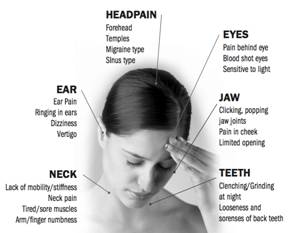TMJ Disorders comprise a variety of signs and symptoms in the head and neck associated with improper function of the temporomandibular joint (TM), head and neck muscles, nerves, and the occlusion (bite).
Sudden changes in occlusion are rarely related to the teeth. Most often the problem is in the TMJ or neck. Muscle pain, although present is very rarely the primary cause. It is typically secondary to an orthopedic problem in the head or neck.
TMD / Orofacial Pain disorders involve pathology within the jaw joints and the associated muscles. Damage within the TMJ may cause a clicking or crunching noise but will often result in changes in the bite, painful teeth, head, neck, and/or ear pain.
The “functional chain” of jaw muscles span from the skull to the collarbone. Symptoms can originate anywhere along this chain. Pain signals travel from the various structures throughout the head, neck, and TMJ into a “junction box” within the brainstem. Most signals must pass a “gatekeeper” before entering the central nervous system but implulses from the trigemenal nerve (TMJ structures and muscles) are the only signals without such a gatekeeper. The whole pain comes directly into the brainstem unaltered and can affect adjacent nerves, causing the pain to be referred to other nerves and muscles.This is why symptoms are so varied and tend to change over time.
Learn more about treating TMJ and why it is important to treat the source and not just the symptoms.
If you experience any or several of these symptoms, it is recommended that you have an evaluation. The earlier the disorder is uncovered, the more effective the treatment. Contact our office today to schedule an appointment for an evaluation.



